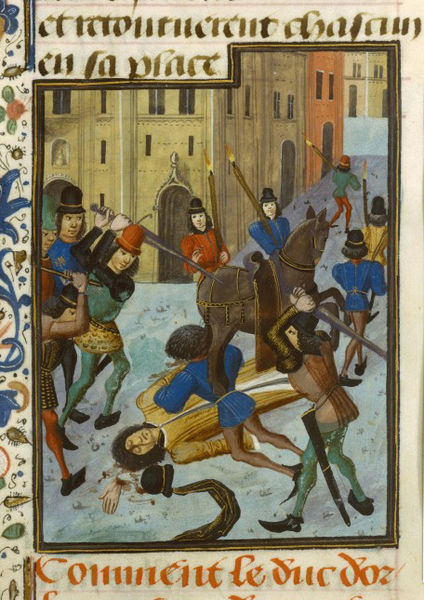Great D&D Moments in History: Ritual Casting in 15th-Century France
In March 1408, University of Paris theologian Jean Petit stood before a audience of distinguished notables assembled in the royal residence in Paris and described how an evil duke had had the third-level spell cause disease cast on King Charles V of France:
 |
| Charles VI |
The duke made the acquaintance of an apostate monk, a knight, a squire, and a servant who knew how to go about the devil’s own work. He ordered them to do a thing that would destroy the king and to accomplish this he gave them the use of a castle at Lagny-sur-Marne.... He also gave them a sabre, a sword, and a gold ring. One morning at dawn these four men left the castle and traveled a quarter of a league to a field where there was a thicket. The monk told the other three to wait there until he called for them and went a little way off by himself, carrying the sabre, the sword, and the ring. The monk drew a figure on the ground and placed the sword inside it on the right, the sabre on the left, and the ring in the middle. Then he stripped himself to his shirt and began reading aloud from a book. Soon a devil appeared. It picked up the sabre and put it down again. Then came another devil, wearing red. It picked up the sword, swung it around, broke off the tip, and told the monk that the thing was done. After this the monk returned to the other three men, and they all went back to the castle.The following night, the four men left the castle again and went to the gibbet at Montfaucon, where they cut down the corpse of a newly hanged man and put it in a sack on the back of a horse.... Afterwards they placed the ring in the corpse’s mouth and passed the sword and the sabre into its anus. Then they said to each other: “It is done.” After this they went to the Duke of Orleans and told him that shortly there would be some news.
The gibbet at Montfaucon (top right)
Soon afterwards, when the king was at Beauvais, he fell gravely ill, so that his hair and his nails fell out.... And from that time on the king was ill, as is known throughout the whole realm, which is a pity. And it is well-known to everyone that the Duke of Orleans was to blame for this illness.
And you thought the sorcerous rituals in Geoffrey McKinney's Carcosa were weird…
Epilogue
The evil duke in question was none other than Louis d'Orléans, the king's own brother. According to Petit's line of reasoning, Louis' heinous use of sorcery (among other crimes) justified his murder, in November 1407, by associates of John of Burgundy in a Paris street.
Most everyone else thought it was rather because Louis had slept with John's wife and siphoned off the financial support John had formerly received from the royal treasury.
Source
A report of Petit’s speech by Thierry Le Roy in Louis Douët-d’Arcq, ed. “Document inédit sur l’assassinat de Louis, duc d’Orléans (23 novembre 1407),” Annuaire-Bulletin de la Société de l’Histoire de France 2 (1864): pt. 2, 6–26, quoted in Eric Jager, Blood Royal: A True Tale of Crime and Detection in Medieval Paris (New York: Little, Brown and Company, 2014), 194–95.
Image credits
Charles VI of France: Codice Ms. Français 165, Maestro di Boucicaut (detail). Biblioteca Universitaria di Ginevra. Reprinted in De Vecchi-Cerchiari, I tempi dell'arte, volume 2 (Milan, 1999) via Wikimedia Commons.
Montfaucon: Execution of disciples of Amaury de Chartres outside Paris, from the Grandes Chroniques de France, illuminated by Jean Fouquet of Tours circa 1455–1460. Paris, Bibliothèque Nationale de France, département des Manuscrits, Français 6465, folio 236.
Murder of Louis d'Orléans: Meurtre du duc Louis d'Orléans, par le Maître de la Chronique d'Angleterre, circa 1470–1480. Paris, Bibliothèque National de France via Wikimedia Commons.



Comments